[ad_1]
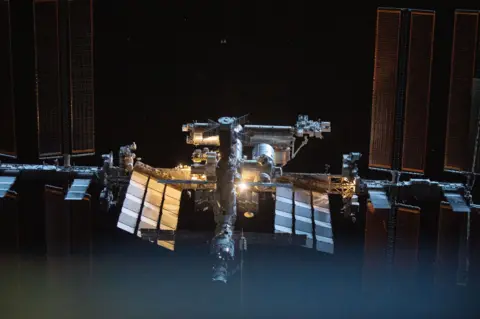 NASA
NASAIn June two American astronauts left Earth anticipating to spend eight days on the Worldwide House Station (ISS).
However after fears that their Boeing Starliner spacecraft was unsafe to fly again on, Nasa delayed Suni Williams and Butch Wilmore’s return until 2025.
They’re now sharing an area concerning the dimension of a six-bedroom home with 9 different folks.
Ms Williams calls it her “glad place” and Mr Wilmore says he’s “grateful” to be there.
However how does it actually really feel to be 400km above Earth? How do you take care of difficult crewmates? How do you train and wash your garments? What do you eat – and, importantly, what’s the “area odor”?
Speaking to PJDM Information, three former astronauts reveal the secrets and techniques to surviving in orbit.

Each 5 minutes of the astronauts’ day is split up by mission management on Earth.
They wake early. At round 06:30 GMT, astronauts emerge from the phone-booth dimension sleeping quarter within the ISS module referred to as Concord.
“It has the very best sleeping bag on the planet,” says Nicole Stott, an American astronaut with Nasa who spent 104 days in area on two missions in 2009 and 2011.
The compartments have laptops so crew can keep involved with household and a nook for private belongings like pictures or books.
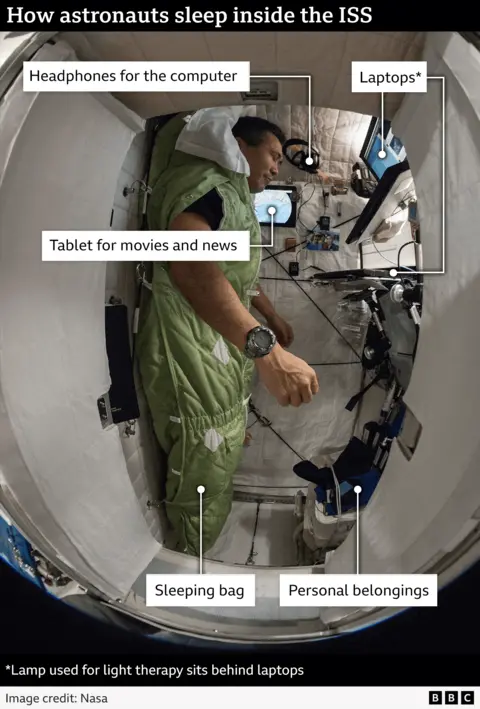
The astronauts would possibly then use the lavatory, a small compartment with a suction system. Usually sweat and urine is recycled into ingesting water however a fault on the ISS means the crew should at present retailer urine as a substitute.
Then the astronauts get to work. Upkeep or scientific experiments take up most time on the ISS, which is concerning the dimension of Buckingham Palace – or an American soccer area.
“Inside it is like many buses all bolted collectively. In half a day you would possibly by no means see one other individual,” explains Canadian astronaut Chris Hadfield, commander on the Expedition 35 mission in 2012-13.
“Individuals simply do not go zipping by way of the station. It’s huge and it is peaceable,” he says.
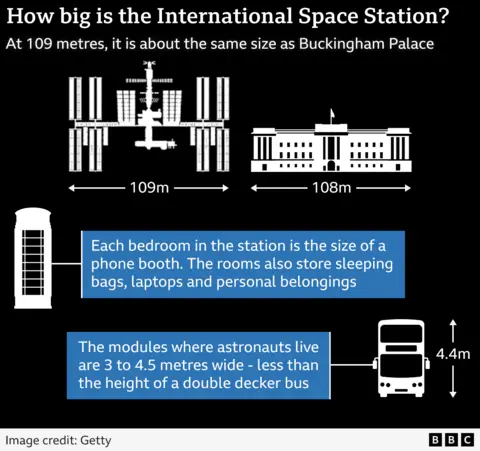
The ISS has six devoted labs for experiments, and astronauts put on coronary heart, mind or blood screens to measure their responses to the difficult bodily setting.
“We’re guinea pigs,” says Ms Stott, including that “area places your bones and muscular tissues into an accelerated ageing course of, and scientists can be taught from that”.
If the astronauts can, they work sooner than mission management predicts.
Mr Hadfield explains: “Your recreation is to seek out 5 free minutes. I might float to the window to observe one thing go by. Or write music, take pictures or write one thing for my youngsters.”
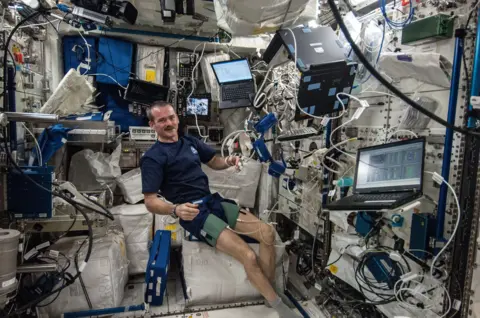 Nasa
NasaA fortunate few are requested to do a spacewalk, leaving the ISS for the area vacuum outdoors. Mr Hadfield has achieved two. “These 15 hours outdoors, with nothing between me and the universe however my plastic visor, was as stimulating and otherworldly as every other 15 hours of my life.”
However that spacewalk can introduce one thing novel to the area station – the metallic “area odor”.
“On Earth we have now a lot of totally different smells, like washer laundry or recent air. However in area there’s only one odor, and we get used to it shortly,” explains Helen Sharman, the primary British astronaut, who spent eight days on the Soviet area station Mir in 1991.
Objects that go outdoors, like a swimsuit or scientific equipment, are affected by the sturdy radiation of area. “Radiation types free radicals on the floor, they usually react with oxygen contained in the area station, making a metallic odor,” she says.
When she returned to Earth, she valued sensory experiences rather more. “There’s no climate in area – no rain in your face and or wind in your hair. I respect these a lot extra to this present day now,” she says, 33 years later.
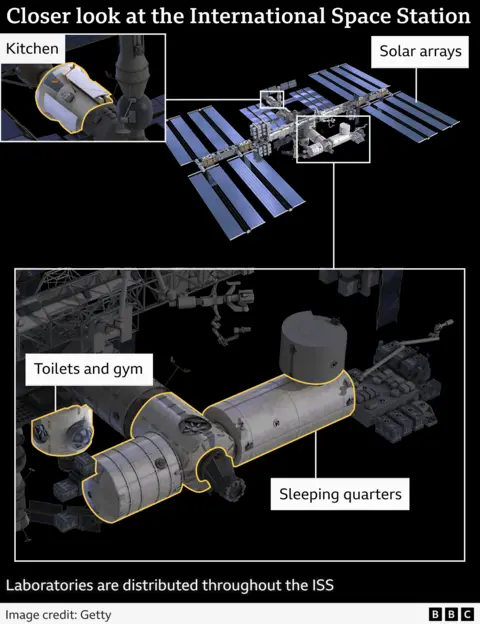
In between working, astronauts on lengthy stays should do two hours of train every day. Three totally different machines assist to counter the impact of dwelling in zero gravity, which reduces bone density.
The Superior Resistive Train System (ARED) is sweet for squats, deadlifts, and rows that work all of the muscle teams, says Ms Stott.
Crew use two treadmills that they need to strap into to cease themselves floating away, and a cycle ergometer for endurance coaching.

‘One pair of trousers for 3 months’
All that work creates a variety of sweat, Ms Stott says, resulting in an important challenge – washing.
“We do not have laundry – simply water that types into blobs and a few soapy stuff,” she explains.
With out gravity pulling sweat off the physique, the astronauts get coated in a coating of sweat – “far more than on Earth”, she says.
“I might really feel the sweat rising on my scalp – I needed to swab down my head. You would not need to shake it as a result of it simply would fly all over the place.”
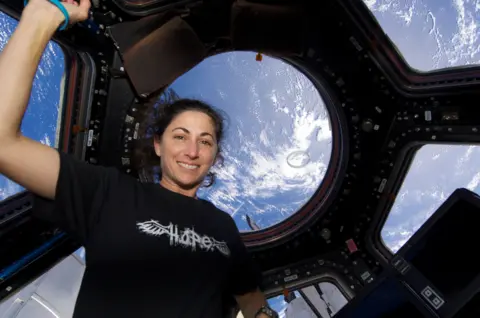 Nasa
NasaThese garments grow to be so soiled that they’re thrown out in a cargo car that burns up within the ambiance.
However their every day garments keep clear, she says.
“In zero-gravity, garments float on the physique so oils and all the pieces else don’t have an effect on them. I had one pair of trousers for 3 months,” she explains.
As a substitute meals was the largest hazard. “Someone would open up a can, for instance, meats and gravy,” she says.
“All people was on alert as a result of little balls of grease drifted out. Individuals floated backwards, like within the Matrix movie, to dodge the balls of meat juice.”

Sooner or later one other craft would possibly arrive, bringing a brand new crew or provides of meals, garments, and gear. Nasa sends a number of provide autos a 12 months. Arriving on the area station from Earth is “superb”, says Mr Hadfield.
“It’s a life-changing second if you catch sight of the ISS there within the eternity of the universe – seeing this little bubble of life, a microcosm of human creativity within the blackness,” he says.
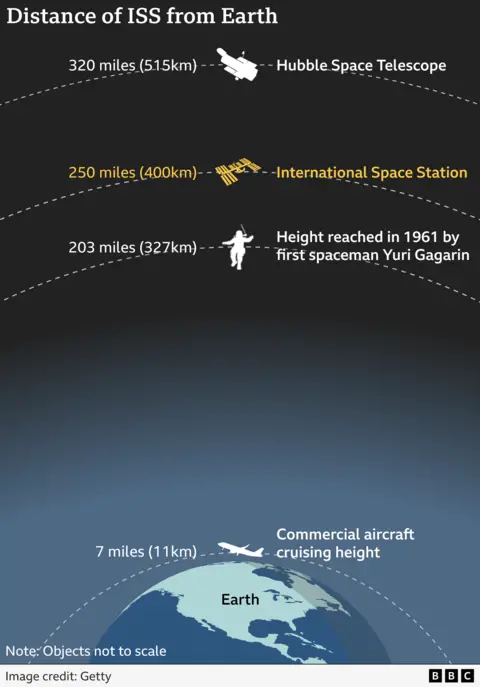
After a tough day’s work, it’s time for dinner. Meals is generally reconstituted in packets, separated into totally different compartments by nation.
“It was like tenting meals or army rations. Good but it surely could possibly be more healthy,” Ms Stott says.
“My favorite was Japanese curries, or Russian cereal and soups,” she says.
Households ship their family members bonus meals packs. “My husband and son picked little treats, like chocolate-covered ginger,” she says.
The crew share their meals more often than not.
Astronauts are pre-selected for private attributes – tolerant, laid-back, calm – and educated to work as a staff. That reduces the chance of battle, explains Ms Sharman.
“It’s not nearly placing up with any individual’s unhealthy behaviour, however calling it out. And we all the time give one another metaphorical pats-on-the again to assist one another,” she says.
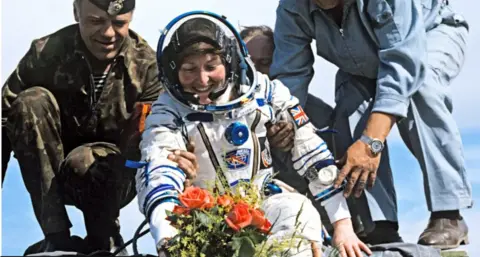 Ria Novosti/Science Picture Library
Ria Novosti/Science Picture LibraryLocation, location, location
And eventually, mattress once more, and time to relaxation after a day in a loud setting (followers run continuously to disperse pockets of carbon dioxide so the astronauts can breathe, making it about as loud as a really noisy workplace).
“We are able to have eight hours of sleep – however most individuals get caught within the window Earth,” Ms Stott says.
All three astronauts talked concerning the psychological affect of seeing their residence planet from 400km in orbit.
“I felt very insignificant in that vastness of area,” Ms Sharman says. “Seeing Earth so clearly, the swirls of clouds and the oceans, made me take into consideration the geopolitical boundaries that we assemble and the way really we’re fully interconnected.”
Ms Stott says she liked dwelling with six folks from totally different nations “doing this work on behalf of all life on Earth, working collectively, determining find out how to take care of issues”.
“Why cannot that be taking place down on our planetary spaceship?” she asks.
Ultimately all astronauts should depart the ISS – however these three say they’d return in a heartbeat.
They don’t perceive why folks assume the Nasa astronauts Suni Williams and Butch Wilmore are “stranded”.
“We dreamed, labored and educated our total lives hoping for an prolonged keep in area,” says Mr Hadfield. “The best reward you may give an expert astronaut is to allow them to keep longer.”
And Ms Stott says that as she left the ISS she thought: “You are gonna have to tug my clawing fingers off the hatch. I do not know if I’ll get to return again.”
Graphics by Katherine Gaynor and Camilla Costa
[ad_2]
[ad_1]
#ISS #life #Nasa #astronauts #Suni #Williams #Butch #Wilmore
[ad_2]
, 2024-09-15 13:44:00





